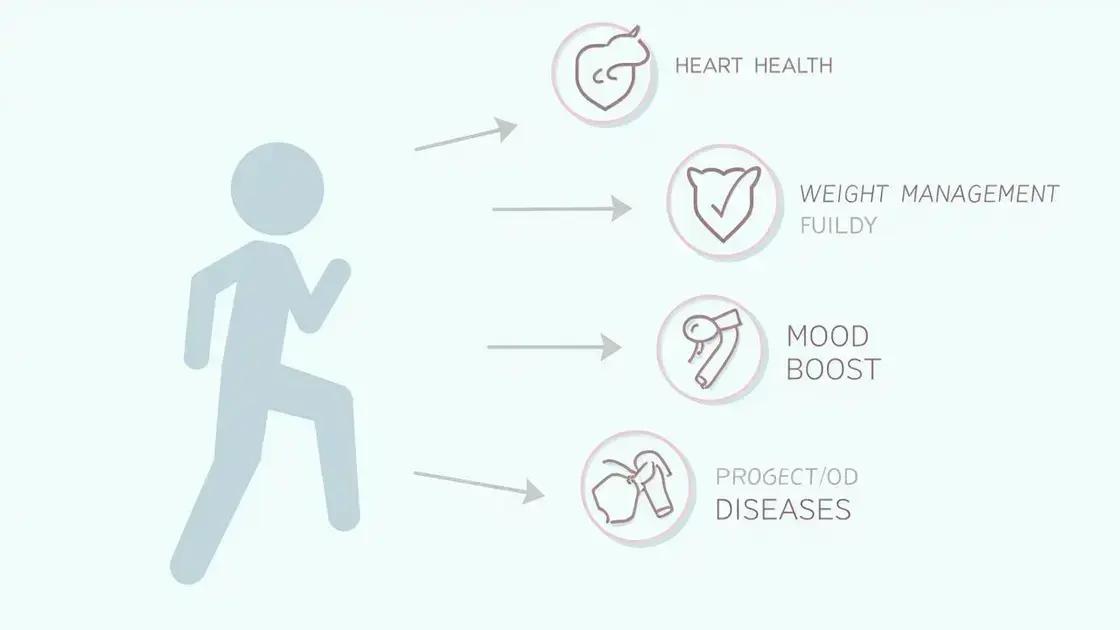To develop a weekly schedule for physical activity, start by setting clear goals, choosing enjoyable activities, and planning specific workout times. Stay flexible to adjust your schedule as needed, and use reminders, accountability partners, and rewards to stay committed. Regularly review your progress to ensure your plan remains effective and enjoyable.
Creating a weekly schedule for physical activity can transform your fitness routine. Regular physical activity is vital for maintaining health and wellness. However, without a structured plan, it can be challenging to stay consistent. In this post, we will guide you on how to develop a practical weekly schedule, ensuring you incorporate exercise into your busy life. From understanding its benefits to actionable tips for adherence, let’s embark on this journey towards a more active lifestyle!
Understanding the Importance of Physical Activity

Understanding the importance of physical activity is essential for a healthy lifestyle. Regular exercise helps maintain a healthy weight, boosts mood, and reduces the risk of disease. Engaging in physical activity can improve heart health, strengthen muscles, and enhance flexibility.
Benefits of Physical Activity
One primary benefit of regular exercise is weight management. By burning calories, we can control our body weight and avoid obesity. Additionally, exercising releases endorphins, which are hormones that lift our mood. This benefit can significantly reduce feelings of anxiety and depression.
Health Risks of Sedentary Lifestyle
A lack of physical activity increases the risk of serious health issues. Sedentary behavior can lead to conditions like heart disease, diabetes, and certain cancers. It’s important to move regularly to avoid these health risks.
Setting Realistic Goals
To enjoy the benefits of physical activity, setting realistic goals is crucial. Start small, like incorporating short walks into your day. Gradually increase the intensity and duration of your activities as your fitness level improves.
Incorporating physical activity into daily routines can be easier than expected. Simple changes, like taking the stairs instead of the elevator or taking short breaks to stretch during work, can make a big difference.
Steps to Create Your Weekly Schedule

Creating your weekly schedule for physical activity can help you stay organized and committed. Follow these simple steps to make a plan that works for you.
Step 1: Set Your Goals
Begin by determining what you want to achieve. Are you aiming to lose weight, gain strength, or improve endurance? Define specific and achievable goals. For instance, aim to exercise at least 150 minutes a week.
Step 2: Choose Your Activities
Select activities that you enjoy and that suit your fitness level. This could include walking, swimming, cycling, or joining a fitness class. Mixing different types of activities can keep things interesting.
Step 3: Plan Your Week
Using a calendar or planner, allocate specific time slots for your chosen activities. Consider your daily routine and where exercise fits best. Block out time for workouts just like any other important appointment.
Step 4: Stay Flexible
Life can be unpredictable, so it’s important to stay flexible. If you miss a workout, don’t be hard on yourself. Adjust your schedule as needed and find new times to fit in your activity. Consistency is key, but flexibility ensures you stay committed.
Keep your schedule visible and review it regularly. Tracking your progress also motivates you to stick with your plan.
Tips for Sticking to Your Schedule

Sticking to your schedule is crucial for achieving your fitness goals. Here are some practical tips to help you remain committed.
Tip 1: Make It Fun
Choose activities you enjoy. If you look forward to your workouts, you are more likely to stick with your schedule. Try new classes or invite friends to join you for added fun.
Tip 2: Set Reminders
Use alarms or calendar notifications to remind you of your workout times. Technology can help keep you accountable. Consider using an app to track your progress and keep records of your workouts.
Tip 3: Stay Accountable
Find a workout buddy or join a fitness group. When you share your goals with others, it increases your motivation. Having someone to check in with can make a significant difference.
Tip 4: Reward Yourself
After achieving certain goals or completing workouts, treat yourself to small rewards. This could be new workout gear, a massage, or a special meal. Rewards create positive reinforcement and keep you motivated to continue.
Tip 5: Listen to Your Body
Pushing too hard can lead to burnout. Pay attention to how your body feels. If you’re tired or sore, allow yourself to rest or modify your activities. Sustaining your schedule means finding the balance between challenge and recovery.
Adjusting Your Schedule for Success

Adjusting your schedule is key to achieving success in your physical activity routine. Life changes can affect your plans, so being flexible can help keep you on track.
Assess Your Progress
Regularly check how you’re doing with your workouts. Are you enjoying them? Are you feeling stronger? If not, it may be time to adjust your schedule or select different activities.
Be Open to Change
Sometimes, unexpected events may disrupt your plans. If you miss a workout, don’t panic. Substitute another day instead. Being open to change helps maintain your routine.
Consider Your Energy Levels
Life can be tiring, so it’s important to listen to your body. If you feel exhausted, you may need to switch up your activities to match your energy levels. Shorter, more intense workouts can be just as effective.
Plan for Setbacks
Prepare for times when you may need to take a break. Whether due to illness, busy schedules, or other challenges, having a backup plan can help you stay motivated. Keep your main goals in mind, so you can return to your routine quickly.
Stay Positive and Encourage Yourself
Always celebrate small victories! If you’ve completed a week of workouts, treat yourself. Positive reinforcement can motivate you to stick to your schedule and continue making adjustments.
In Summary: Building Your Weekly Schedule for Success
Creating a weekly schedule for physical activity is crucial for reaching your fitness goals. By understanding the importance of exercise and following the outlined steps, you can develop a plan that fits your lifestyle.
Stay committed to your schedule by incorporating enjoyable activities, setting reminders, and partnering with support systems. If you find your routine isn’t working, don’t hesitate to adjust it according to your needs and circumstances.
Ultimately, the key to consistency is flexibility. Celebrate your achievements, stay positive, and keep striving for a healthier you!
FAQ – Frequently Asked Questions about Developing a Weekly Schedule for Physical Activity
Why is it important to have a weekly schedule for physical activity?
A weekly schedule helps you stay organized and committed to your fitness goals, making it easier to incorporate exercise into your daily life.
How can I make my physical activity schedule enjoyable?
Choose activities you like and mix them up to keep things interesting. Consider joining classes or exercising with friends for added fun.
What should I do if I miss a workout?
Don’t stress if you miss a workout. Adjust your schedule by substituting another day, and focus on staying flexible with your routine.
How can I track my progress with my physical activity schedule?
Use a planner or fitness app to record your workouts. Regularly assess your progress to see how you’re doing and make adjustments as necessary.
What are some tips for sticking to my activity schedule?
Set reminders, find an accountability partner, and reward yourself for achieving your goals to stay motivated.
How do I adjust my schedule if I’m feeling tired or burned out?
Listen to your body and modify your activities. Shorter, more intense workouts can be effective, and it’s okay to take breaks when needed.












